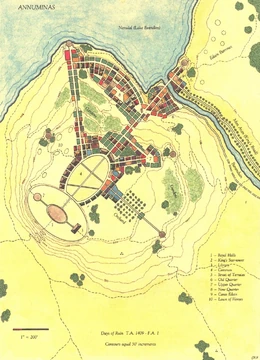|
Annúminas
| |
|
Plan view of Annúminas (MERP)
| |
|
Location of Annúminas (centre) beside Lake Evendim (MERP)
| |
|
Other names
|
Dunhirion; Sunset Tower; Tarkilmar; Torfirion; Tower of the West, Westermanton
|
|
Type
|
City, capital
|
|
Region
|
|
|
Realm
|
|
|
Founded
|
Second Age 3325, by Elendil the Tall
|
|
Inhabitants
|
|
- “Annúminas was the home of Arthedain's Kings before the city was sacked in 1409, when the hordes of the Witch-king overran all the former lands of Arnor. Annúminas once held the position of the fairest of Dúnadan cities in the North, with broad, tree-lined avenues and graceful buildings of white marble. No wall surrounded the city, which was deemed a place of peace and learning. Scavengers have picked most of the ruins clean, but tales abound of sealed vaults underneath the library and the palace.” -Drogil of Fornost
Elendil the Tall, first High King of Arnor and Gondor, had built Annúminas (S. lit. "West-tower", more properly "Sunset-tower") on the hills beside the southern shore of Lake Evendim (S. Nenuial) where river Baranduin exited the lake, between S.A. 3320 and 3325. The city formally became the capital of Arnor after the completion of the royal palace in S.A. 3396. As such, it housed one of the three palantíri of the North-kingdom. After the sundering of Arnor, Annúminas was the titular capital of Arthedain from T.A. 861-1409, although the kings and court spent more and more of their time in Fornost Erain, to which the Annúminas-stone was removed. What remained of Annúminas was sacked and destroyed by the armies of the Witch-king in T.A. 1409.
Annúminas was re-founded in the early Fourth Age after the War of the Ring by King Aragorn Elessar after the re-establishment of the Reunited Kingdom, and again became the capital of a restored Arnor.
Annúminas in the late Third Age:
- Type: Ruined city
- Inhabitants: Half-settled camp for Dúnedain Rangers and wandering Evendim-folk.
- Population: No steady population (after TA 861).
- Origin: Founded in SA 3325 by the High King Elendil on an older Nandor settlement.
Other names[]
- Dunhirion
- Sunset Tower
- Tarkilmar
- Torfirion
- Tower of the West
- Westermanton
Annúminas in T.A. 1409[]
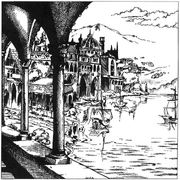
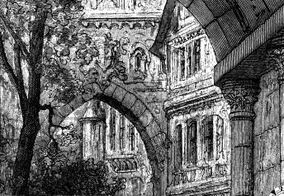
Annúminas changed little through the first centuries of the Third Age. Its expansive design is never compromised by the overcrowding that normally occurs in a capital city; strict regulations prevent slums from developing, and most of the city's laborers live in respectable apartments built with royal funds. Vice and unsavory behavior remains private or is taken to outlying villages to escape the eyes of the city watch. Dol Caras (S. "City Hill") upon which Annúminas stands is solid limestone; an excellent sewer system carries waste southeastward into drain-fields just above bedrock and well below the actual surface of the surrounding pastures and croplands. Only the city's lake shore has direct storm drain outlets. A system of cisterns provides most of the water supply for the upper city, while the lower portion taps wells fed by Lake Evendim.
Elendil's capital was designed without walls; their absence was a matter of great pride to him and later monarchs. The defense and policing of Annúminas stems from five guard towers, the Beraitirion, situated at the primary approaches to the city. The towers and the palace are garrisoned by the Beraid Tirrim, a professional military force. It is similar in organization to the Citadel Guard (Rembar Tirrim) in Fornost; the rest of the city government is similarly duplicated in the eastern capital. While Annúminas and its hinterland have never taken on the bustling, busy atmosphere of great trading and governmental centers like Tharbad in Cardolan or Osgiliath in Gondor, the land around it is prosperous. Farms and estates — both large and small — cluster all around the city. Villas belonging to great lords dot the surrounding hills, providing nobles an idyllic place to rest when visiting the capital on business. The Esgarnen (S. "Bay of Reeds") adjacent to Annúminas, from which the River Baranduin exits Lake Evendim, is too shallow for docking anything but small boats and barges, so small artificial harbors are maintained in lesser bays west and north of the city proper. Boating remains a favorite pastime of the Annúminili throughout the city's history, and most festivals are highlighted by colorful sailing and rowing races, many of them with royal participants. The vast majority of the Annúminili carry no weapons, and martial displays are frowned upon. Jousts and military contests are considered to be in bad taste, something more suitable for the bleak, depressing citadel-city of Fornost. Dueling and brawling are considered the province of drunken laborers, and anyone wandering the streets in armor can expect to be accosted by the watch or guard and questioned. Seers, healers, alchemists, and magicians can always be found in Annúminas, the lesser sort operating small shops, the better ones dwelling in fine houses and taking business only by referral. Scribes and scholars are also common, and students from all over western Endor come to Annúminas to learn from renowned mannish and Elvish loremasters. The Great Common (#4) on Dol Caras is the center of intellectual activity, but political and cerebral ferment can be found in any garden, tea shop, or gallery. Artisans live largely in the lake shore community, and religious mystics dwell on the north bank of the Baranduin, preferring houses and towers in the woods called Taur Edain, beyond the ancient barrows overlooking the lake.
Refer to the "Plan view of Annúminas", above right.
- Royal Halls (Q. Elerrínarondo or "Star-crowned Dome"). The Palantír of Annúminas rests here. The palace is no fortification, but simply a great house built of grey granite among green lawns. Most of the structure is roofed by a single large dome clad with black marble facing. The surface is strewn with silver, gold, and red laen stars that catch and store the light from their heavenly namesakes during certain seasons of the year. The dome glitters at night (using the stored light), providing an easy reference to local star-gazers and overawing even the most jaded visitor. Once the royal family and most of their advisors dwelt within these walls. With the passage of years, the Kings of Arthedain have spent more and more of their time in Fornost, dealing with military matters. The Guardians of the Palantír do, of course, reside here as long as the Seeing-stone rests in its special chamber high up under the dome; regardless, the Elerinarond is now more of a museum and scholarly retreat than anything else.
- King's Star-tower. Almost two hundred feet tall, with a magnificent view of Nenuial. The topmost room boasts three of the largest telescopes in Endor.
- Royal Library. The finest available to Men, excepting possibly that of Osgiliath. Three stories high, but its largest rooms are underground, where the dry limestone of Dol Caras insulates the most fragile volumes against the vicissitudes of northern climate. Only the most privileged of scholars have routine access to its rooms. Others need a royal or noble patron.
- Great Common. A center for gossip, sports, and politics. The open ground is interspersed with stone benches and forums for group meetings and theater. The buildings along the northern side hold the administration of the monarchy, while those along the southern side are the town-houses of the most important nobles and officials, including the Royal Mayor. The eastern and southeastern edges are reserved for commerce, although wandering sellers of food, wine, and beer can be found anywhere.
- Street of Terraces. The residences along the middle and lower reaches of this street are traditionally owned by the most elite of the city's seers and spellcasters. The Istari Saruman and Gandalf rented quarters here for a time after they first came to Middle-earth.
- Old Quarter. Literally the oldest section of the city, and the only one with buildings designed by other than the Royal Architects. An Eriadoran village stood on this spot in the late Second Age, trading in the bounty of the lake and providing servants for the Dúnadan astronomers living on the Dol Caras. Rubormyrax, the peculiar fellow who runs the Augury, an alchemy and herbalist's shop along the river, is the oldest resident of Annúminas. A Peredhel of Silvan and common descent, he believes himself to be a bloodwraith. Rubormyrax sleeps in a homemade crypt in his cellar, avoids running water and fire, and eats his meals cold. Once a month, he walks out under the full moon, convinces himself that he is too guilt-ridden to take a mannish victim, and drinks the blood of a sheep instead. This would be a harmless enough bit of insanity, save that a Dark Priest, Mercaver, is now one of the only three people in Annúminas who know Rubormyrax' secret. Mercaver, an Angmarean spy, has murdered three others who possessed the knowledge, and when he is the Peredhel's only remaining "friend," intends to use him and his considerable knowledge of the city to penetrate the Royal Library and the Elerinarond. If anyone can trick Rubormyrax into eating an apple spiked with cloves or bathing in a stream or river, the curse that caused his condition will be dispelled. Then Mercaver will stand in peril; Rubormyrax is more ancient than he knows, and he has powers and skills that even true Undead could not match.
- Upper Quarter. Dwelling place of the city's gentry and merchants. The more prestige they have, the closer to the Royal Common they live. The wood just beyond the last row of houses on the edge of the hill is the favorite trysting place for young swains and maidens.
- New Quarter. Home of the city's shopkeepers, artisans, lesser civil servants, and workers. Most of the buildings in this neighborhood house several families, the result of the strict building codes and limitations enforced by the Royal Mayor.
- Caras Edain. A first stopping point for travelers from the east, and site of the city's only two cheap inns. An Adan village stood here in the First Age; barrows dot the ridge to the east. The road up the hill leads to the Taur Edain, a forest that serves as the chief source of firewood and timber for the city. It also provides secluded locations for religious retreats.
- Lawn of Heroes. Burial sites for those who have died in the service of the kingdom.
Ruins of Annúminas after T.A. 1643[]
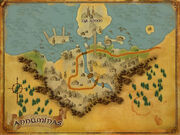
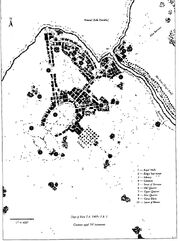
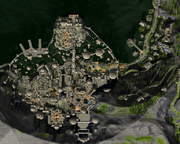
The contrast between the former and current capitals of the kingdom of Arthedain was stark and foreboding: one was dead and the other vibrant with uncharacteristic militarism. Set like a jewel upon the southern shore of Nenuial (Lake Evendim), Annúminas — the first and only capital of Arnor — once shimmered against the nighttime sky, its many festive torches a glowing marker for all traveling the North Kingdom. Little remained now but chipped, stone blocks and collapsed pillars; the faint outline of a great city stretched across the windy hills on Nenuial's shores. At night, Annúminas was a haunting, desolate, dark place offering haven and direction to none.
The city and all the constructions around it were utterly destroyed by the Witch-king's forces in 1409. Only a few locations were of note in the years after. Refer to the "Ruins of Annúminas (MERP)" plan view at right.
- Royal Halls. The Elerinarond has fallen, and the Palantír was removed to Fornost. Scavengers have secured most of the precious objects, metals, and jewels from the dome, but a few remain if anyone has the organizational skills to set up a crane under cover of darkness and quietly clear out a few really large boulders before the local lord gets wind of the operation. Under one boulder lies the body of Urgregim, an Olog who was crushed by the falling walls of the palace. In exchange for a giant ebony skull-medallion that gave Urgregim the strength to crush a building with a single blow of his club, the Witch-king put a geas on the Troll that does not allow him to die until Arthedain falls. Urgregim has been in considerable pain these past 234 years. If he is released, he would exact vengeance from anyone in the immediate area; his second priority will be staying alive long enough to achieve his goal of slaying the rulers of both Arthedain and Angmar. Another boulder covers the revenant of Emerithil the Dark. He was commander of the Tirrim Aran under Arveleg, the King of Arthedain who was slain in the defense of Amon Sul in T.A. 1408. Guilt-ridden, he swore never to rest until the last of the Witch-king's minions were slain or driven out of Arthedain. Urgregim dropped an enormous slab on Emerithil while he was trying to cover the escape of some of his soldiers' families from the burning royal palace. Emerithil's will held his spirit to his body and has kept it there through the years. If the Troll is released, Emerithil might be freed as well, since he is nearby. If not, his mind will reach until it locates someone who can free him. Emerithil's half-decayed body is hideous, and he scrapes off little bits of himself off as he brushes against rough objects. Aside from a fierce temper and abrupt manner, Emerithil is not a bad fellow. He will find local allies with enough courage to abide his presence; then he will hunt down and slay Urgregim.
- King's Star-tower. The royal observatory was mostly destroyed, but it remains the only sheltered camping site on Dol Caras.
- Royal Library. The ruins of the library sprawl above its still-intact underground chambers.
- Great Common. The common is overgrown. The local lord, Belvor o Calembar, dwells in a small keep about three miles south of the ruined city. He does not allow the grazing of sheep on Dol Caras, including the bramble-choked common in his ban. Anyone who stays overnight on the common has a chance (20%) of experiencing dreams about the fall of the city, some of which might contain useful information, and some of which might just be nightmares.
- Street of Terraces. The street still provides a way to get carts up Dol Caras from the lake side, unseen by Belvor and his soldiers.
- Old Quarter. A small fishing village, called Lakehead and inhabited mainly by Rivermen, has transformed the Old Quarter of Annúminas. Rechorca, a Logathig Easterling, has stayed among the fisher folk for months, drinking up his life savings. He felt compelled to come to Annúminas, and is using hard liquor to control his urge to visit the Lawn of Heroes. He is certain a dreadful fate will overtake him if he does so. Sooner or later, he knows, he is going to run out of drinking money. Since he is, in fact, a retired Angmarean soldier, he is unsure of where to turn for help.
- Upper Quarter. Nothing remains save a pair of lovelorn ghosts. The spirits are two young people who lost their lives in the war before they could be married; they are relatively harmless and bashful and will fade with time. There is a chance (50%) that anyone spotting them among the woods catches the pair unclothed.
- New Quarter. Ruins gradually erode into the lake. The crumbling walls are a favorite hiding place for local thieves.
- Caras Edain. The road is still intact, and the great stone bridge has been replaced by a wooden one. The inns have been rebuilt; one of the innkeepers occasionally fires cheap wooden crossbow quarrels across the river at a rival on the other side, just to annoy him. The forest has regrown since it was burned down in the war, but some of the trees bear images of the martyrs nailed to their trunks before the wood was fired. Most of the religious houses have moved elsewhere. One of the barrows is now inhabited by a lesser wight. If no one discovers what has been killing sheep on this side of the river, the wight may be able to taint other barrows and summon other evil spirits.
- Lawn of Heroes. The tombs were pillaged in T.A. 1408 and resealed two years later. Curiously, they periodically show signs of disturbance, although no one has ever caught a grave robber. In fact, the Angmareans holding the pillaged weapons and gear from long ago develop a deep need to visit Annúminas. Few realize that their weapons are the source of their compulsion. Once arrived at the Lawn of Heroes — without losing or selling the tainted object, or without slaying themselves along the way, or simply dropping dead from fear and depression — they feel a final need: to dig open the appropriate grave and bury both the cursed weapon and themselves in it. Their animated corpses still protect several of the tombs on the hill from grave-robbers. The locals who possess this information are not currently sharing it with anyone, but might if pressed or bribed. Rechorca, the Easterling in Lakehead, has not yet asked the correct questions on the topic. The Arthadan dagger he is carrying has been through so many owners that he does not know its origins.
- Ranger's Ward.
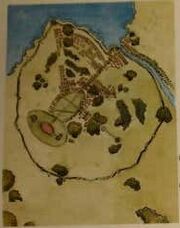
Places of Note[]
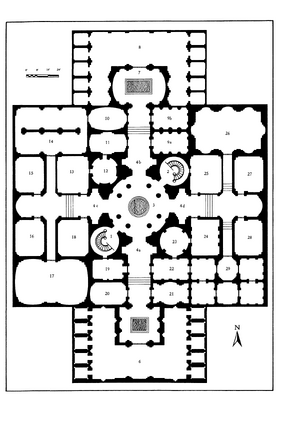
- Caras Edain
- Dol Caras
- Eastern Barrows
- Esgarnen
- Great Stone Bridge
- Great Common
- Hill of Kings
- Hill of the Palantír
- Hill of Westernesse
- King's Star-tower
- Lake Evendim
- Lakehead
- Lawn of Heroes
- New Quarter
- Old Quarter
- Royal Halls (S. "Elerinarond" or "Star-crowned Dome")
- Royal Library
- Street of Terraces
- Upper Quarter
Inhabitants[]
Men (Dúnedain of the North):
- Third Age:
- Before TA 1650: Arveleg II
- TA 1409: Emerithil the Dark Mercaver Rubormyrax
- TA 1640: Belvor o Calembar Bethsammen Elenuil Emerithil the Dark Kaur Rechorca Urgregim
References[]
- MERP: Arnor
- MERP: Rangers of the North - the Kingdom of Arthedain

